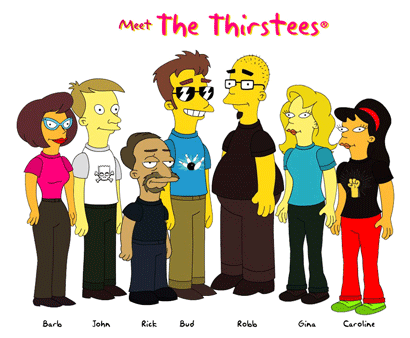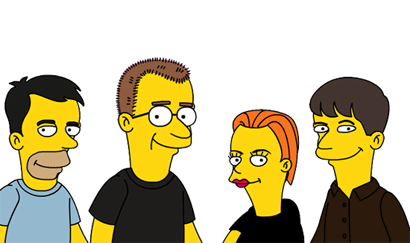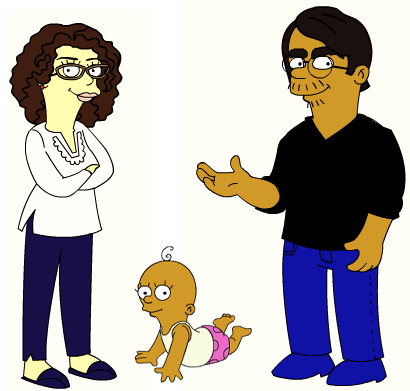I have been watching The Simpsons since its first season when I was a zitty teen with an unwieldy, rollercoastery voice, much like the perennial entry-level employee, Jeremy Peterson. I used to watch it in Mexico, on Television Azteca’s channel 13 — which in retrospect is as FOX-ey as America’s FOX (i.e., straddling the fine line between genius and retardedness) — in Spanish, where Homer’s voice was one of the best vocal castings I have ever listened to. When we installed a satellite dish in our childhood home, I transitioned to the English version and haven’t stopped watching since. Much to Bryony’s chagrin. As the longest-running sitcom in history, clocking in at 18 years, the show has experienced extreme highs and lows, going anywhere from 20 million viewers to a paltry 6 million per episode, resulting in a diluted and relatively small, semi-cult following of geeks and dweebs (like me!), that can recall every funny line in every episode, much to the bemusement of normal people. The Simpsons is a black or white compromise, you either hate it or you love it, and it’s the latter that is rarer. So it’s especially impressive that a high-stakes movie, with unpredictable box office results, led by a group of obsessive and controlling creatives could become a national, über-hyped brand experience. And, against all odds and current trends, actually deliver.
For more than a year, when The Simpsons Movie was confirmed for release in 2007 by 20th Century Fox sometime in April of 2006, the series’ intense fan base was set abuzz and its creators were happy to fan the flames with titillating trailers and false plot lines, generating immense online and off-line speculation and expectation. The feelings only intensified as the unconventional promotions were stretched throughout the year, culminating these past months in the form of 7-Eleven stores transformed into Kwik-E-Marts, a 180-foot-tall rendering of Homer Simpson in his undies next to the historically significant Cerne Abbas Giant in Dorset, UK, and a 14-state contest to see which lucky city of Springfield would host the official movie premiere. And through an unexpected major advertising campaign with some serious media-buying dollars behind it, most cities were treated to omnipresent movie posters and billboards of Homer ogling a sprinkled, pink-glazed doughnut that further whet fans’ appetites. As a viral capper, Crispin Porter + Bogusky, working their client base by cross-promoting with Burger King, helped launch simpsonizeme.com, a site where you can upload a picture of yourself and be transformed into a Yellowie cartoon. Of course, this was not utterly original; M&M’s did it recently, South Park has been letting people fulfill their potty-mouth dreams for a while, and Nintendo’s Mii avatars made it socially cool to flaunt your digital self. Yet the Simpsons’ closeness and mocking similarities to our own reality make it a successful guilty pleasure that tickles us with the fantasy of living in their world.


The crew from 3st.

Creative Review’s editorial team: Gavin, Patrick, Eliza and Mark. Do check their blog, as they have a real strong addiction to this.

Us: Bryony, Maya (sort of), and me.

We’ve seen overblown promotions (The Da Vinci Code) and flat-aired internet hype (Snakes On a Plane) more than once, only to falter under criticism or tank over lack of asses in seats. But, as was proven on the weekend of July 27, The Simpsons Movie toppled box office fears with a $74 million opening and, as far as I have read in a myriad of places, positive critical acclaim. I recently saw the movie and, without spoiling anything for anyone, I thought it was magnificent. From the moment the 20th Century Fox logo comes on screen to when the cleaning crew comes into the theater officially ushering you out, the movie delivers with jab after jab after jab and an endless array of knockouts. Three years ago, at the HOW Conference in Chicago, Brian Collins proposed that attending church was the ultimate branded experience: the music, the shared purpose, the seating arrangement, the light coming in from the stained glass, the ritual of a Sunday. Not to belittle religious traditions by comparing it to an animated series, but the full-circle effect of going to The Simpsons Movie after a year of expectation, 18 years of commitment, two or three months of wide-eyed promotional bombardment, and sharing 87 minutes with equally giddy viewers, proved to be the perfect culmination to a fully-branded experience.
It’s easy to overlook the dense mythology of The Simpsons as puerile. Yet it’s the result of almost two decades of character development and storytelling paired with the series’ button-pushing and risk-taking ethos that has allowed the Simpsons to succeed unequivocally in stringing together a medium-bending marketing campaign that paved the way to one of the hardest adaptations of an animated television sitcom to a full-length feature film. What the Simpsons have that others like, say, The Flinstones, never had is a deep pool of brand assets rooted in our own culture, politics, history and lifestyles that establishes an unshakeable connection with our world. Whether it’s Itchy & Scratchy’s questionable kiddie-pleasing violence, Fat Tony’s similarities to Mr. Soprano, the Rich Texan’s business recklessness, Nelson’s unfulfilling bulliness, Comic Book Guy’s improbable chance of ever fitting in, the Krusty burgers’ heart-clogging amount of grease and Rainier Luftwaffe Wolfcastle’s Schwarzeneggerness — to single out but a few parallels — along with an endless parade of real-life cameos, amplified by the creators’ willingness to take any topic or situation to its extreme possibilities, the aftertaste of the Simpsons is realistically bittersweet. Just like our own world. Regardless of the Simpsons’ dwindling season viewers the success of this movie, in all of its irreverent, slapstick, politically-belittling approach, is testament to their relevance beyond simple comic relief. Most brands promise a better, sexier, happier, more fulfilled and cunning you, the Simpsons on the other hand, as a brand — and this cast of hundreds have proven that together they are one (and that they can move currency around to boot) — promise a distorted mirror view of you, and some like what they see while others don’t. As an alternative to the equally, if slightly more toxic, distorted view that most brands offer, I think I prefer my world on the yellow side. Just like the past 18 years.








Is it me, or should Maya have more hair and a nookie?
On Aug.14.2007 at 08:58 AM